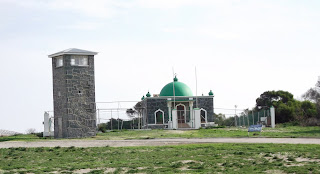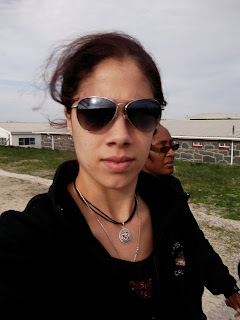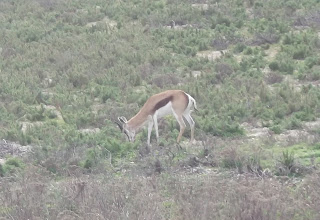This is the Clock Tower at the V&A Waterfront (Victoria and Alfred waterfront) which is where many a tourist has gone in order to get some one of a kind South African seafood cuisine. Here if you take a right you reach the Nelson Mandela Gateway which is where you take the ferry to go to Robben Island.
This is the Nelson Mandela Gateway. I'm on the dock about to load onto the extremely ghetto looking ferry. While loading, two guys were taking pictures of people loading for future purchase. When I was loading and they found out I was alone, they not only announced it to EVERYONE in line behind me but also shouted out that I was " Still on the lookout for true love" so all single guys should see me. . . great. . .
Anyhow to continue the chronicle of my island getaway trip. .
This is the front entrance of the prison. We didn't go through the gates, we loaded the buses which took us around the island. There are 190 permanent residents on the island, most of which are staff of the Robben Island Museum which keeps the prison intact and operational for tourists. The island sees about 1800 new people per day. Most inmates would describe these gates as the entry way to hell.
These were the first prisoners into the prison many years ago. As you can see, prisoners were mainly black (Bantus) and were forced to wear khaki colored uniforms to distinguish between prisoners and their status in the prison.
This is a Kramat.
The Kramat was designed for religious purposes, for the islamic prisoners to go worship. However, it was actually designed for psychological warfare purposes by the apartheid in order to get prisoners to be extremely divided because of religion. It wasn't successful, because the prisoners in the prison were (political prisoners), all mainly there for the same purpose: because they tried to bring down the apartheid.
This is the leper cemetery. The lepers that were brought here were brought to be in isolation as were most lepers throughout history. Like most prison areas, Robben island is filled with tombstones everywhere, and the prison was built on top of a large burial area. a Penguin waddled in front of this grave site later in the day when we were heading back to the ferry. There are approximately 1400 people estimated to be buried here.
This is the limestone quarry where the prisoners were forced to work 9 hours a day. The pile of rocks in the middle of the road is from previous prisoners that had gathered together a few years ago and placed there. The rocks are different colors to symbolize the different colors that unite South Africa after it's darkness with the apartheid. Nelson Mandela and President Zuma were both there at the ceremony which took place a few years ago. FYI: President Zuma spent ten years serving time here as well. It seems like in order to qualify to be a South African leader (or government official) you need to have spent time serving at Robben Island Prison.
The only school on the island. It was built much later after the prison closed in order to provide services for the children on the island. There are 18 there who attend this school.
The former house of the british governor who was based at the island years ago. It now is the conference center for Robben Island employees. The wall you see here is made of blue limestone which was also built by the prisoners (as well as the house in the back). The limestone has caused many lung health problems with ex-political prisoners who are still alive. For example, Mandela was hospitalized a few weeks ago for lung issues from his time in the rock quarry.
This is the chapel on the island. It is an anglican church. It used to be the leper's church for them to pray to get better. My tour guide emphasized that you can in fact get married here if you want, even on valentine's day. Marriage, he believes is for life, similarly, to the amount of time prisoners spent on this island. So wrong, but so very very true. So for those of you who are interested in getting married here, booking is 50 ZAR (South African Rand) which is approximately $7.35. So book now!
The inside of one of the areas where they kept the prisoners to sleep
A menu for daily meals. Notice the difference in quality depending on what you were categorized as.
Your prisoner card. Had to be carried with you at all times in your left chest pocket.
A typical mat the prisoners slept on. You also received two blankets to use all year upon entering the compound. The mat is something that resembles the old style mattress padding that dogs use.
The yard. As you can see, my photography skills were able to capture the mood of the prison. It's a solemn place where time meant little to nothing to those who were forced to spend their days here. Solitary confinement was the worst torture of all, where lack of communication led most to become insane.
The kitchens were prisoners worked. Misbehaving led to solitary confinement which has been described as the most brutal form of punishment an inmate could receive. You were placed in a windowless cell with nothing or no one to talk to for days. You received one meal per day.
Compound D. This is where Nelson Mandela was imprisoned. He wrote quite frequently in the small garden here and those manuscripts he hid in the garden. They would later be gathered and made into his book titled "The long walk to freedom". Mandela was also an avid tennis player who was quite good at it and played frequently with the other inmates.
The fourth window is Mandela's cell window.
Mr. Mandela's cell. He spent 18 of his 27 years in this cell serving his time. It hasn't been touched since he left it many years ago. The bin to the left is the toilet which inmates had to empty every morning and night before going to sleep. Random fact: Mr. Mandela was prohibited from entering the United States until July 2008 because he is labeled as a terrorist in South Africa. He was later pardoned of course, but before that was only allowed to visit the United Nations in Manhattan.
Currently, Mr. Mandela is spending the rest of his days on the Eastern Cape in his hometown. He's turning 93 next month.
This was the ex-political prisoner who showed us around the prison. He served 8 years here. He was imprisoned for treason for his involvement with the ANC against the apartheid from 1982-1990. While he was being arrested he was tortured by being strapped to a wooden chair and electrocuted. He was put through this many many times until he told the officers what they wanted to know about his colleagues and what they were up to. He was a very kind man, but you could tell from his presence that he had seen and been through much. His eyes were that of someone who had been broken down like a wild animal that had been taken from the wild and put into captivity. He called me "lovely".
Me walking around the prison.
Below are happy photos after all the previously depressing ones.
He was a bit of a diva. Posing for my camera by the bus then waddling (quite fast) in front of the cemetery :). Aren't they adorable?
SPRINGBOK!!!
It's a type of african gazelle which is a principle red meat here. It's also the name of the national rugby team here which I mentioned in a previous post. They are also indigenous to Cape Town.
Cape Town harbor at sunset.
Cape Town from Robben Island. It's been called the mother city because it looks like a woman laying down looking up at the sky. Can you see it?
I hope you all enjoyed the pics. More are on the way since I just invested in my own camera.
Good night,
Carolyn




























ah fascinating - my history lesson for today:) xx
ReplyDelete